College Board MCQ Test 2 Corrections
This blog goes over some of the questions on the Collegeboard Final for Tri 1 as well as my strengths and weakness in certain areas,
- Overview
- My Score
- Reviewing Questions I Got Wrong
- Reviewing Questions That I Got Right, But Took Me Time to Figure Out
- Final Reflection/Personal Takeaways
- College Board Suggestion :)
Overview
This blog shows some of the questions that I either got wrong or forced me to think about the answer for a little while before getting it right. It also goes into detail on questions I got wrong and what I can do better to not make that same mistake on a question like that for the future.
My Score
The final exam was 50 questions for a grand total of 50 points. I earned a score of 45/50 (90%), as shown below:
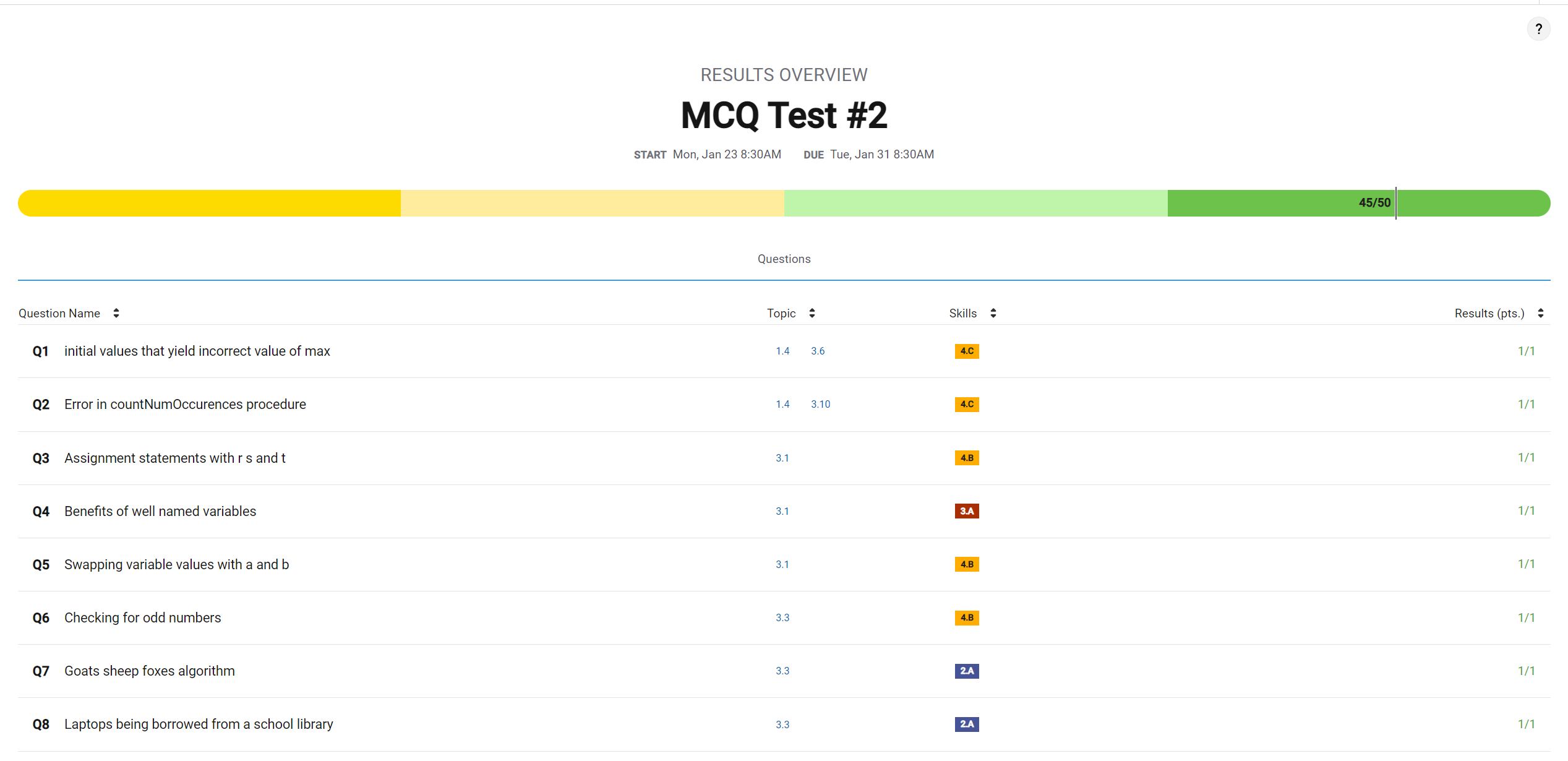 My overall score indicates that I showed a relatively good understanding of what we have been learning through College Board. The questions that I got wrong were questions 17, 21, 22, 27, and 30.
My overall score indicates that I showed a relatively good understanding of what we have been learning through College Board. The questions that I got wrong were questions 17, 21, 22, 27, and 30.
Reviewing Questions I Got Wrong
Question 17 (wrong)
The first question to review (that I got wrong) is question 17, which is shown below:
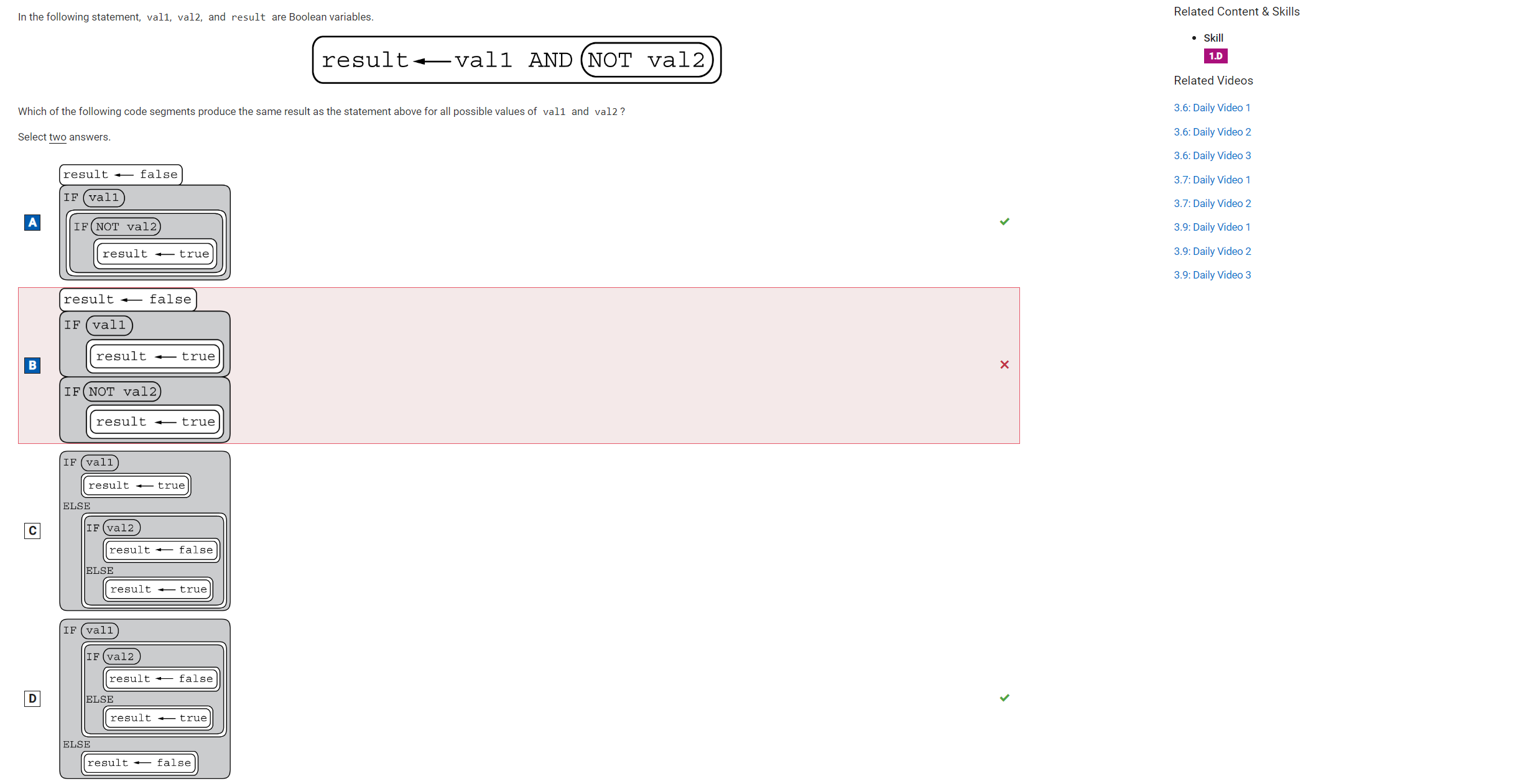
There were two correct answers, which were A and D. Although I selected A as one of the correct answers, because I selected B, which is not a correct answer, I did not get the point for this question. I knew for sure that A was one of the correct options, as I knew that the result would be the same as the one in the question if val1 and NOT val2. I likely chose option B, however, because I thought that there would be no need for nested conditionals (if/else statements) when this is not the case. I probably thought that by having two different if statements that the result would still come out to be the same. The next time I get a question like this, I will make sure to read the lines of code for each option given and to remember how nested conditionals work and how boolean variables work, as forgetting something like those concepts on the actual AP exam could result in me getting what is supposed to be a simple question wrong.
Question 21 (wrong)
The next question to review is question 21, which is shown below:
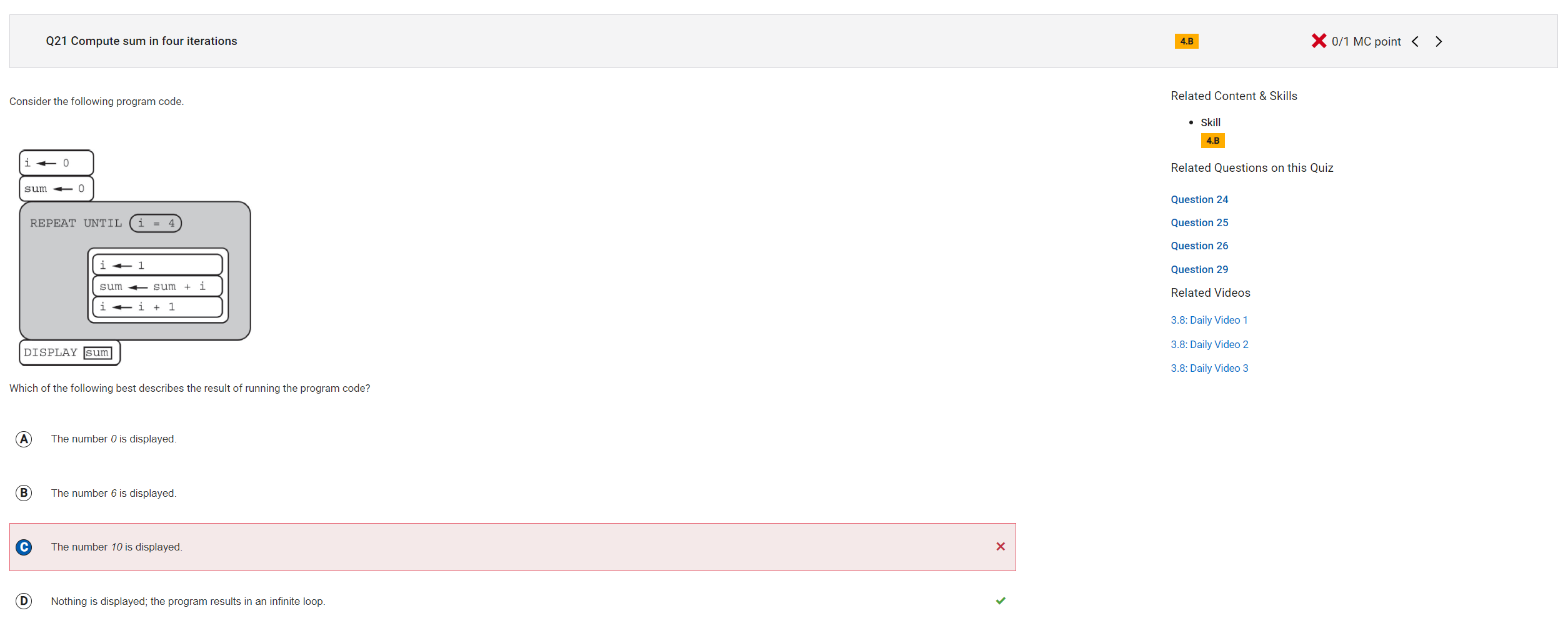
The correct answer for this question was D, which was that nothing would be displayed because the program is in an infinite loop. I chose answer C, however, and looking back at this question, I can clearly understand how and why I made this mistake. I thought that since the segment inside the “repeat until” started at i = 1 that it would actually go to i = 4; however, what I didn’t realize as I was doing this question is that the variable i is always going to have a value of 1 and is never going to reach i = 4. Therefore, the program gets stuck in an infinite loop and will not display anything. One way I can prepare myself better for a question like this is to be mindful of what is inside the conditional (or in this case, “repeat until”), as reading that portion carefully will inform me of whether the program gets stuck in an infinite loop or not.
Question 22 (wrong)
The next question to review is question 22, shown below:
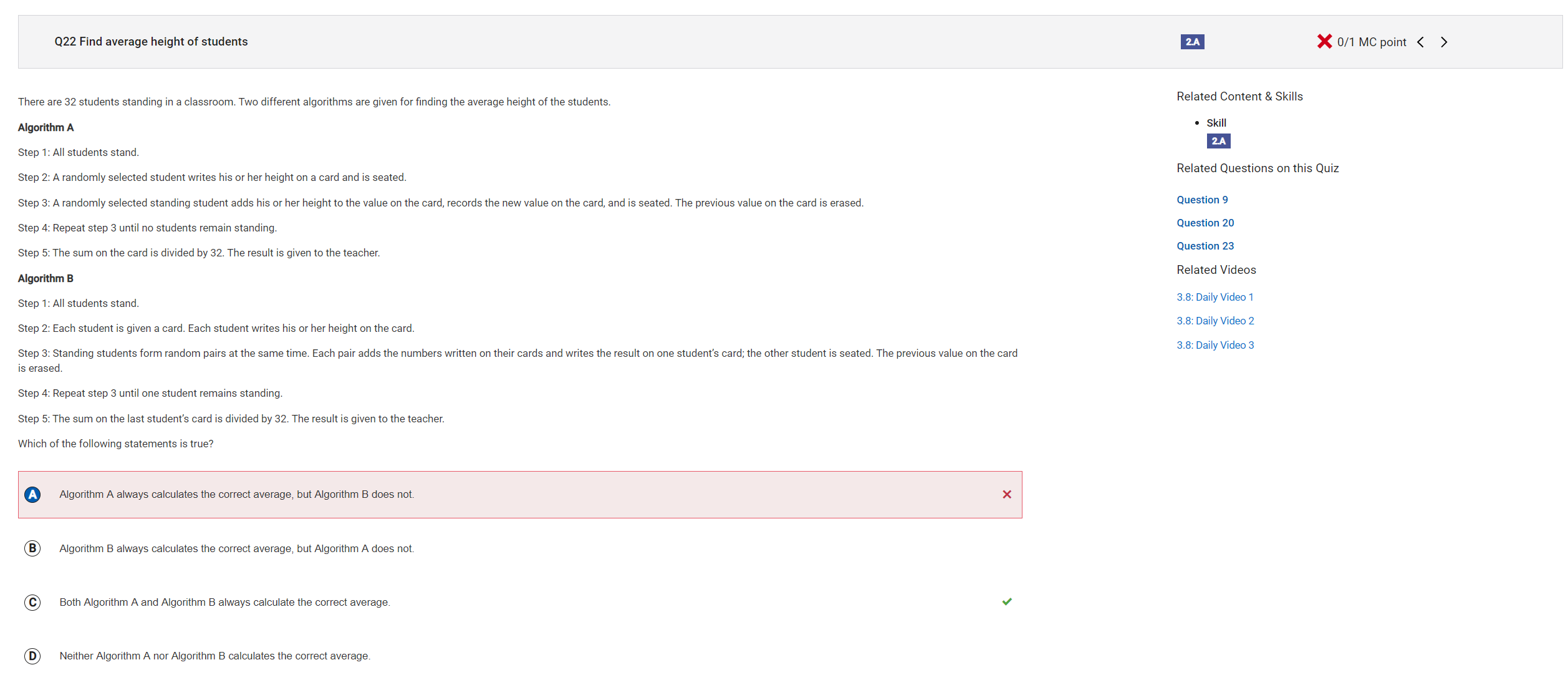
The correct answer for this question was C, which was that both algorithms yielded the correct average height in the classroom. For this question, I was likely having a difficult time trying to understand was Algorithm B was saying, which probably drove me to believe that Algorithm B would not calculate the correct average and that therefore only Algorithm A does. When I now look at how I got this question wrong and reread both algorithms, I now understand and am able to visualize how each of the algorithms worked. I now know that Algorithm B was essentially having each pair add up the values on the cards and repeating this process until there was only one student left standing, and how dividing that result by 32 will give the same correct average as Algorithm A. For a question like this where it does not have code and is all in words, I can improve my ability to answer these questions correctly by really reading the algorithms carefully and make sure I know how to visualize what is happening. This way, I will be less likely to make the same mistake that I made when I answered this question.
Question 27 (wrong)
The next question to review is question 27, which is shown below:
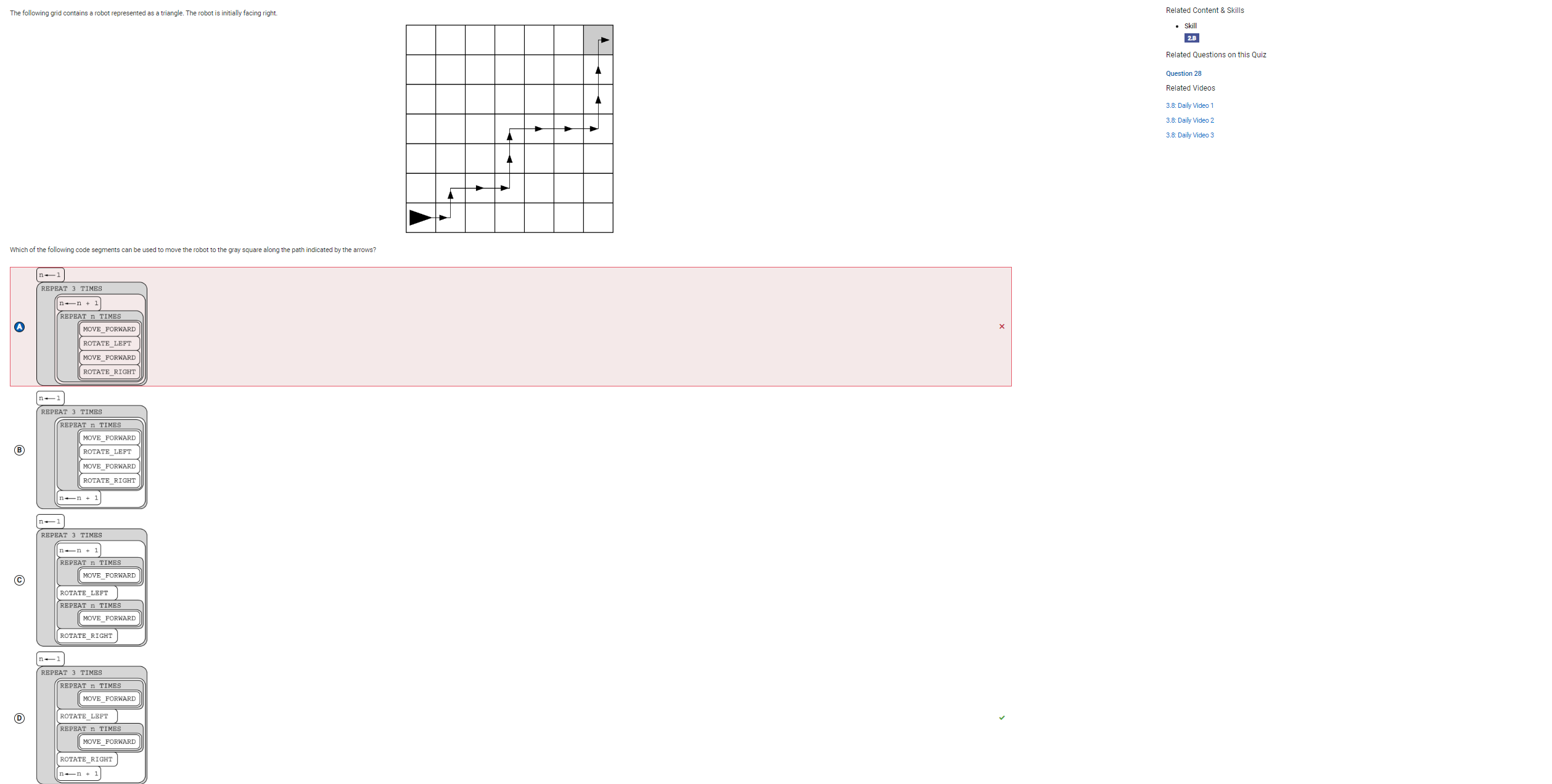
The correct answer to question 27 was D, as shown above. I actually had a difficult time understanding what this question was asking, as I struggled in deciding which answers to eliminate and which answers were possible correct ones. As I am looking back and reviewing this question, I am starting to understand where I went wrong, but I have still not 100% understood this question to the point where I can answer a very similar question like this correctly. One way I can improve myself in this area is to watch some of the College Board videos (also shown in the image above) that relate to questions like these, as those videos will definitely help improve my ability to answer a question like this and teach me how to approach them. I definitely learned a lot about myself and my understanding of this topic from this one question, and I believe that this will help me become better prepared for the upcoming AP exam.
Question 30 (wrong)
The last question to review (that I got wrong) is question 30, shown below:

This question had two correct answers, where were choices B and C. While I did choose C as one of the correct answers, the other answer I chose was A, which was not one of the right options; thus, I did not earn the point from this question. I knew that C was a correct answer, as I knew that the code segment provided would just go from the circle with the largest radius to the circle with the smallest radius and produce the picture as it is given in the question. I chose A and not B as an answer, however, as I did not take into account where the line of code “drawCircle(x,y,r)” was written. Me getting this question wrong was mainly due to me not carefully reading EVERY single option given, as when I saw option A, I immediately jumped to conclusions and believed that it was the right answer and did not consider the fact that there could be options in which the line of code drawCircle(x,y,r) is placed differently in the program. The next time I get a question like this, I will make sure to read all of the answer choices, even if there are some that are obviously wrong, as there could be an answer that you skipped that ends up being the right answer.
Reviewing Questions That I Got Right, But Took Me Time to Figure Out
While reviewing questions that I got wrong on this test is essential, it is also important to consider questions that took me time to figure out or required me to really think, even if I ended up getting the question right. This section reviews questions
Question 5 (correct)
The first question to review is question 5, shown below:

I ended up choosing the correct answer for this question, which was B, shown in the above image. Question 5 involved swapping the values of variables a and b using temp as the temporarily variable. Although the concept of this is very straightforward, I had to ensure that I was keeping track of what was changing and what was being kept the same, as losing track can lead me to pick the wrong answer on a question that is fairly easy to answer. For a question like this, I can improve my confidence in answering it correctly by perhaps writing everything down, as it can sometimes be difficult to try and do everything in your head. This way, by writing down what is happening on a piece of scratch paper or something to write on, I will be more certain about which answer is correct and be able to move on to the next question without any hesitations.
Question 12 (correct)
The next question to review is question 12, shown below:

While I did choose the correct answer, just like question 5, I needed to make sure that I understood what each variable represented and that I did not lose track of each variable’s description, as doing so could have led me to pick the wrong answer. For a question like this, I can minimize the amount of time it takes for me to think about what the answer is by jotting down a few notes or even words about each variable’s description. This way, by labeling each variable with specific key words, I will be more likely to remember what each variable represents and therefore will reduce the possibility of me answering the question wrong.
Question 29 (correct)
The next question to review is question 29, shown below:

I chose the correct answer for this question, which was option A, where the robot or triangle was essentially in the middle of the set of squares. I ended up almost choosing a wrong answer (D), as I initially thought that the robot always repeated every movement three times. Thankfully, however, I realized that each time the robot performed the set of movements that they end up repeating it one less time than previously, which is shown in the last line of the code segment that has “n <- n-1”. Had I not realized this, I could have gotten this question wrong. This question required me to imagine the robot moving along each of the squares, and I had to be much more cautious compared to other questions that involve swapping the values of variables. For a question that involves robots moving along a grid or something similar, it is important that I understand the code segment given (if any) and how that contributes to the functionality of the program, as while keeping track of the robot’s movement is critical, it is also just as, if not more, important to understand concepts regarding code, as that understanding can also have an impact on if I get the question right or wrong.
Question 37 (correct)
The next question to review is question 37, shown below:
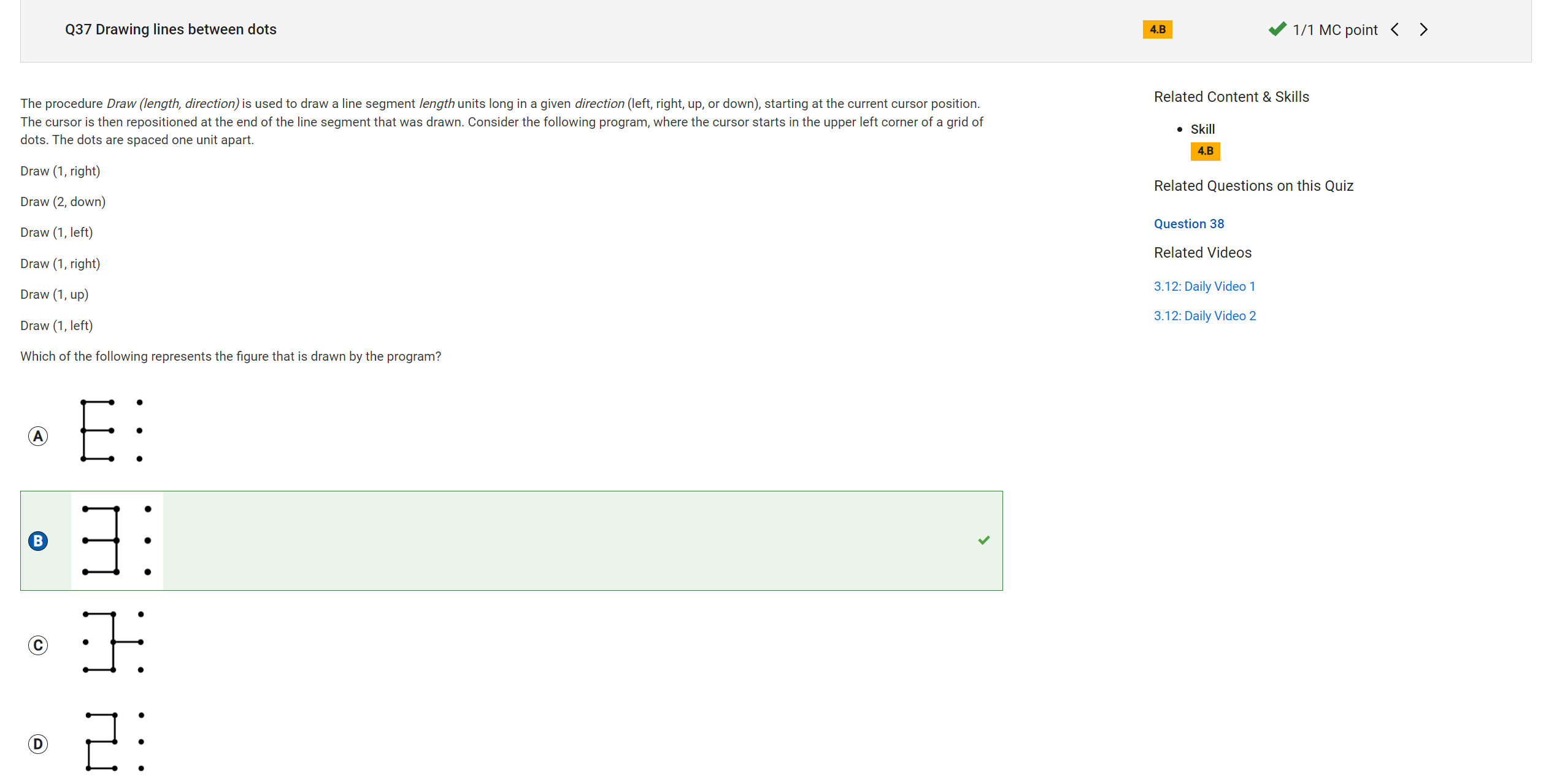
For this question, I chose the right answer, which was B (the drawing that looks like a 3). Although the concepts related to this questions are fairly straightforward, this was also another question in which I had to carefully keep track of everything that was happening in the procedure. Since it can be difficult for me to draw out the line segments in my head and keeping track of everything, I used a whiteboard to help me see what the length of each line segment was as well as each one’s direction. I found this very helpful, as I was able to compare the drawing I made to the drawing options presented, and I immediately knew to choose B as the answer, as my drawing ended up looking like a 3. I heard from Mr. Mortensen that on the AP Exam MC, we will be provided with some scratch paper if needed throughout the exam, which will definitely be a useful tool when it comes to questions like these and other questions reviewed here.
Final Reflection/Personal Takeaways
Overall, I am very happy with the score that I earned, as it shows that I have a good understanding of what we have studied in this class so far and shows me that I can answer multiple choice questions like these really well. The questions I got wrong were also a learning experience for me, as it made me realize how I can approach those kinds of questions in the future to ensure that I do not make those same mistakes again. I like having these opportunities to test myself on what we have learned so far and seeing how well I do, as they almost always are a true learning experience for me. These kinds of tests show me what my strengths and weaknesses are and tell me how I can improve, and I really hope that I reflect great improvement in answering MCQ questions when we have our multiple choice final for this trimester.
College Board Suggestion :)
Although this is not the most important thing, I think College Board could improve something when it comes to multiple choice tests such as the one I just took. I noticed that after I submitted the test that they only provide explanations for some of the questions and not all of them, especially questions such as the ones I got wrong or took me some time to think about. I wish College Board could add explanations for correct and incorrect answers for more of those questions, as this way, I will immediately know why I got the question wrong and how not to make the same mistake again. I understand that it is important to review the question ourselves, but it can sometimes be difficult to understand why you got a question wrong if you do not understand it in the first place, so College Board adding an explanation would be useful to students like me.